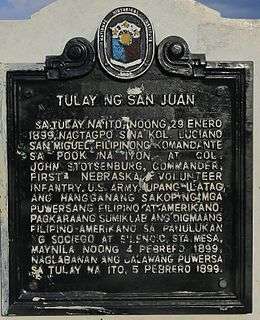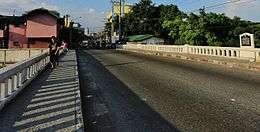San Juan River Bridge
Coordinates: 14°36′06″N 121°01′13″E / 14.601660°N 121.020302°E
| San Juan River Bridge | |
|---|---|
|
Bridge of San Juan del Monte, 1899 | |
| Carries | 2 lanes of vehicular traffic; pedestrian sidewalks |
| Crosses | San Juan River |
| Other name(s) | Bridge of San Juan del Monte |


The San Juan River Bridge (Filipino: Tulay ng Ilog San Juan), also known as San Juan del Monte Bridge, is a boundary bridge between the city of San Juan and Santa Mesa, one of the sixteen (16) areas of Manila, Philippines. The 40-meter bridge connects the N. Domingo Street in San Juan and Old Santa Mesa Street in Manila. The location of the bridge served as a battlefield during the 1896 Philippine Revolution against the Spaniards and the 1899 Philippine–American War.
On, January 29, 1899, Colonel Luciano San Miguel, Filipino Commander had his first meeting with Colonel John M. Stotsenburg, Commander of the First Nebraska Volunteers on this bridge to discuss the boundaries of their respective forces. On February 4, 1899, an encounter between the Filipino and American forces led to a shooting incident and sparked the Battle of Manila (1899).[1]
On February 5, 2009, the National Historical Commission of the Philippines installed a historical marker on San Juan River Bridge commemorating its role to the start of the Battle of Manila.
History
After Emilio Aguinaldo issued the Philippine Declaration of Independence on June 12, 1898, at Kawit, Cavite, there still was uneasy peace around Manila.[2] Filipinos revolutionaries felt that Spain simply ceded the Philippines to the United States who were determined to take over from where the Spaniards left off. American forces started to come between June and July 1898 where 8,000 were deployed around Manila and 11,000 more deployed along the Zapote Line.
On December 5, 1898, the First Nebraska Volunteer Infantry under Colonel John M. Stotsenburg, started to camp in Santa Mesa, Manila just near the San Juan River Bridge. Their camp was surrounded on three side by Philippine forces led by Colonel Luciano San Miguel. The Nebraskans were outnumbered so they had to build their defense consisting of a series of outposts. They had regular patrol around the area since they felt restless on their location.[3]
On the evening of February 4, 1899, Private William Walter Grayson, Private Orville Miller and another soldier were patrolling the area when they encountered insurgents. Grayson and Miller asked them to "Halt!" but the armed men continued to advanced. This prompted Grayson to fire the first shots and retreated back to their line. This spread to the other parts of the line and sparked an exchange of shots between the Filipino and American.
The following day, February 5, 1899, General Elwell Stephen Otis deployed his troops to Santa Mesa and later on sparked the Battle of Manila [4]
The Battle of Manila started just two days before the US Senate ratified the Treaty of Paris (1898) on February 6, 1899. The war that lasted till 1902 resulted in the death of more than 4,200 Americans and over 20,000 Filipino nationalists.[5]
References
| Wikimedia Commons has media related to San Juan River Bridge. |
- ↑ "City of San Juan". www.sanjuancity.gov.ph. Retrieved 2 June 2014.
- ↑ Churchill, Bernardita. "The Philippine-American War (1899-1902)". www.ncca.gov.ph.
- ↑ Silbey, David. "Command Posts: A focus on military history, policy and fiction". www.commandposts.com. Retrieved 3 June 2014.
- ↑ Silbey, David. "FEBRUARY 4, 1899: THE START OF THE PHILIPPINE-AMERICAN WAR AND PATRON-CLIENT FIGHTING". www.commandposts.com. Retrieved 3 June 2014.
- ↑ "The Philippine-American War, 1899–1902". history.state.gov. Retrieved 3 June 2014.
External links
- City of San Juan
- National Commission for Culture and the Artr
- Command Posts: A focus on military history, policy and fiction
- US Department of State, Office of the Historian
